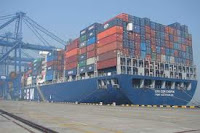In its latest Vital Signs shipping report, Macquarie found that the current boxship orderbook would produce a 10% increase in the global fleet’s size next year, falling to 6% growth in 2012.
“Based on our view that volumes will achieve minimum growth of 8% a year, we are potentially facing a shortage of capacity in 2012,” said the authors.
 “The orderbook as a percentage of the current fleet is approaching lows last seen in 2003, ahead of the last boom in containership profits.”
“The orderbook as a percentage of the current fleet is approaching lows last seen in 2003, ahead of the last boom in containership profits.”Alphaliner estimates that some 6.7% of the orderbook has been cancelled since the beginning of the global financial crisis in October 2008, while scrapping has also made a sizeable dent in capacity.
In 2009, only two new containership orders were placed and this year, the 55 vessels that have been ordered equates to just 2.2% of the existing fleet.
Macquarie said: “Due to solid deliveries year-to-date, the orderbook has fallen to 26.4% of the cellular fleet from 36.1% in January and a peak of 64.2% in November 2007.”
Just a year ago many in the industry were predicting that it would take until 2015 for supply and demand to return to balance. But in the first half of this year, the rebound in demand on most routes, led by intra-Asia and Asia-Europe, saw lines return to profit early, helped by the use of slow-steaming strategies.
According to Macquarie, collective operating profits for 20 of the world’s 30 largest containership operators, for which data is available for the first half of 2010, totalled US$3.8 billion, compared with US$6.9 billion a year earlier,
In previous upturns, lines have ploughed profits into new vessels, but the pace of orders is being stymied by the hole in balance sheets after losses and constraints on financing, especially for non-vessel operating owners.
“Of the orders placed this year, only 23% have come from non-operating owners,” said Macquarie.
Weakened balance sheets and the reduced participation of non-operating owners will slow the build-up of the orderbook for much of next year, with orders only likely to be placed in any great numbers towards the end of 2011, it said.
“We believe that if there is any sign of greater-than-expected softness in demand, the industry will respond with extra-slow-steaming.”
BY IFW
We are the export in Malaysia.We tried to find out the reason that Why did the Containership fleet grows? Could you tell me more an information?
The world’s active containership fleet has grown by 15% over the last six months, according to analyst AXS Alphaliner. Figures from Paris-based Alphaliner show the fleet grew from 11.5 million teu at the start of 2010 to 13.3 million teu by the end of June. The 1.78 million teu increase comprises newbuilds of 740,000teu and the reactivation of 1.16 million teu of ship capacity laid-up during the recession. Alphaliner said the increase was “in stark contrast” to 2009, when active capacity fell 2.3% and idle capacity reached a peak of 1.5 million teu in December. Alphaliner said: “Despite the influx of newbuildings, the idle capacity dropped from 1.51 million teu at 1 January to 0.35 million teu at the end June. “This was largely due to the higher-than expected recovery in demand in the first half of the year and to the impact of extra-slow-steaming, which has absorbed an additional 320,000teu teu in six months.” The analyst added: “The pace of scrapping has slowed considerably since last year’s highs. Container vessels scrapped in the first six months of this year amount to 111,000teu. “Another 8,500teu was removed through conversions of cellular ships into other types {bulk carriers and sheep carriers].” Alphaliner said the active capacity of all the top-20 carriers had increased in the last six months, except NYK, which had embarked on a new strategy of reducing its exposure to the liner trades. In February, NYK sold five of its 6,148teu ships.